Phillip Island Beachcombing - Treasures From The Sea
Ah! Feel the sand between your toes with some Phillip Island beachcombing.
Nothing relaxes the mind and body more than a walk along the beach looking for shells.
Or seeing what the sea has washed up onto the tide line.
Apart from shells you might find shark egg cases, sponges, egg masses, cuttle bone or sea glass.
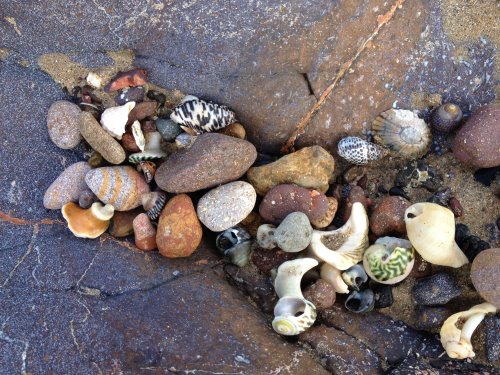
Some species of shells are protected.
They are identified on signs at beach entrances. Please do not remove these shells.
Fisheries and Wildlife Department personnel patrol the coast.
By the time a shell has been washed up onto the beach, the creature that used it as a home has usually gone.
If there is still a creature inside, leave the shell on the beach or return it to the sea.
Is This Sea Creature Dead Or Alive?
It’s great fun to go rock pool rambling or beachcombing, but we don’t want to accidentally kill animals.
Below are some tips for you to remember when you discover interesting creatures in tide pools or along the shore.
Starfish
Starfish have tiny tentacles under each arm. If the tentacles are moving, the starfish is alive. To double check, touch gently or put in the water to see if it starts moving. If not sure, leave alone. I have a lovely dry biscuit sea star but it very smelly - it might be better left for bird and crab food!
Shark egg cases
There are several types of shark egg cases to be found on Phillip Island. If a case has a split at one end it is dead, with no embryo inside. If it is intact and has fluid inside, leave it in the water for it to continue living and developing.
Egg case masses
Hold egg case masses up to the light. If you see tiny things floating in fluid, leave it in the sea.
Sea urchins
Living sea urchins have spines protruding over their bodies. If the spines are intact, it might still be alive. A live urchin will also feel heavy. If the spines are worn off and the inside dry and hollow it is definitely dead.
Shells
If a bivalve shell is intact and tightly closed, then there is a living creature inside. If you touch an open bivalve and it closes it is obviously alive!
With spiral shells you can easily see if there is a creature at home - either the original mollusc or a hermit crab. Many molluscs have a “door’ called an operculum, which they use to block the shell entrance so they can close themselves tightly inside. Leave it, as it’s alive.
I love to look for sea urchin shells as they are great for decorating my seaside home.
Learn how to clean sea urchins here
 From this..........
|
 ..........to this
|
To help keep our beaches clean, bring a bag with you to collect any rubbish such as plastic. This can also save the life of seabirds and sea creatures which often mistake shiny plastic as food.
One shell to avoid is the anemone cone shell. They have a toxin which they use to immobilize prey.
Do not pick up live anemone shells.
The shell can be up to 8cm long but on Phillip Island is usually around 4-5cm and is common in the tide line debris.
The irregular patterns on the shell can be in purple, brown or white tones.
Shells
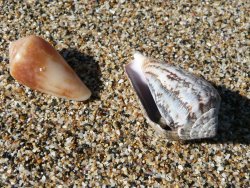
Anemone Cone Shell
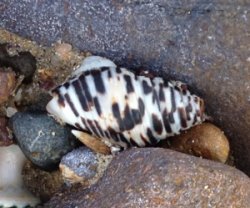
Lined Cominella
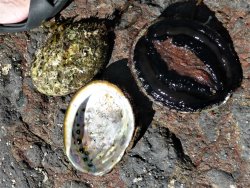
Abalone
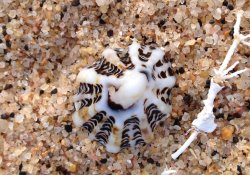
Ribbed Limpet
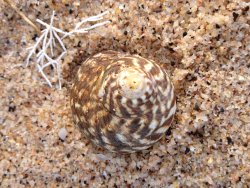
Warrener (Turban) Shell
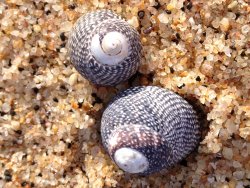
Top Shells
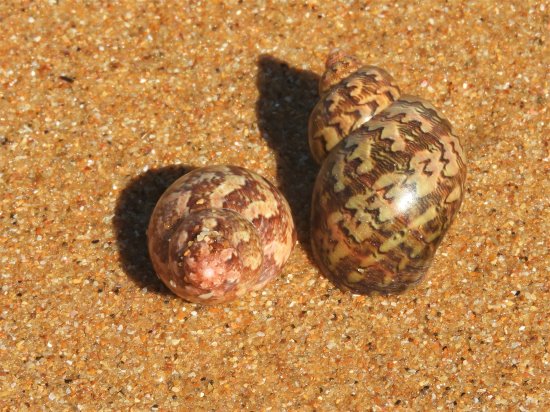 Painted Lady Shells |
Egg Masses
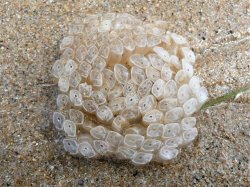
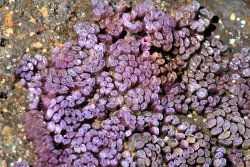
Dicathais Orbita
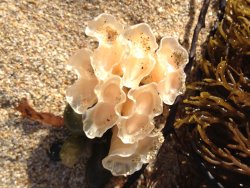
Tulip Shell
Flotsam and Jetsam
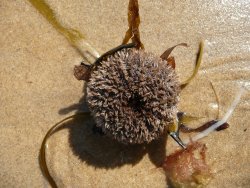
Sea Urchin Case
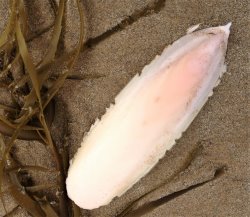
Cuttlebone
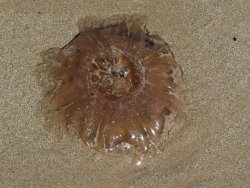
Jellyfish
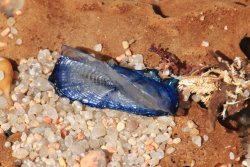
By The Wind Sailor
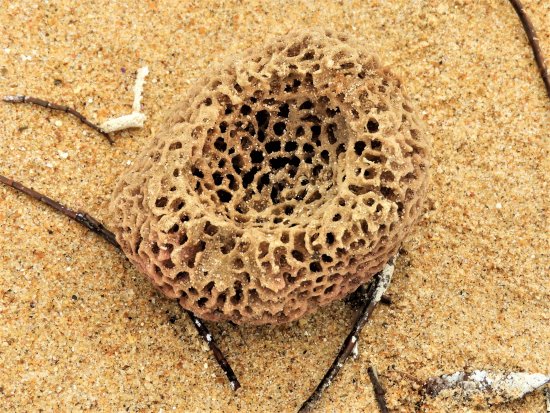 Sponge |
Pumice
One of the more unusual finds on Phillip Island’s beaches is pumice.
Pumice is formed when an underwater volcano erupts. These eruptions occur more frequently than is generally known. The gas-rich frothy magma from the eruption cools quickly, trapping gas bubbles within the rock, forming pumice. Pumice is a highly porous rock that is light enough to float on water.
Floating on the ocean, pumice can become waterlogged and sink, but a lot is also washed up on beaches.
A famous case regarding pumice was a pumice raft
found by sailors in the Pacific Ocean in 2019. This raft resulted from an
eruption near Tonga, with the raft expected to reach Australia.
Probably the most common use for pumice is as an abrasive for removing callouses and dead skin from feet, but it has many other uses as an abrasive.
The pumice pieces found on Phillip Island’s beaches are very small but quite distinctive once you know what to look for.
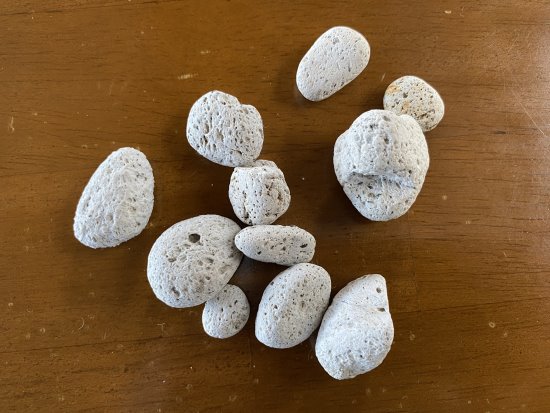
Pumice Found On Phillip Island Beaches
Shark Egg Cases
Some of the most unusual finds when beachcombing are shark egg cases.
The females of some shark species lay egg cases from which baby sharks later hatch.
On Phillip Island I have found four different types.
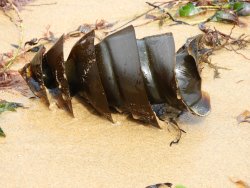
Port Jackson Shark Egg Case
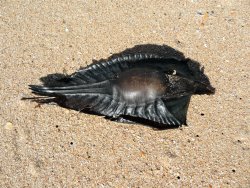
Elephant Shark Egg Case
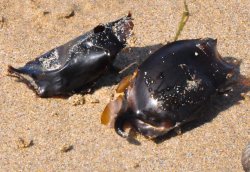
Carpet Shark Egg Cases
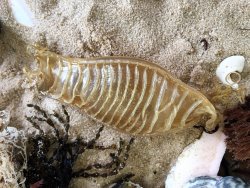
Draughtboard Shark (also known as Swell Shark) Egg Case
Sea glass is weathered glass which has been frosted and rounded by the sea. It could have been rolled in the sea from 20 to 30 years for the characteristic texture and shape.
Coming from sources such as broken bottles, tableware and shipwrecks sea glass can come in different colours including green and brown, with white (clear) being the most common.
Usually found after king tides or at low tide after a storm, sea glass is popular for making jewellery and decorative pieces such as mosaics.
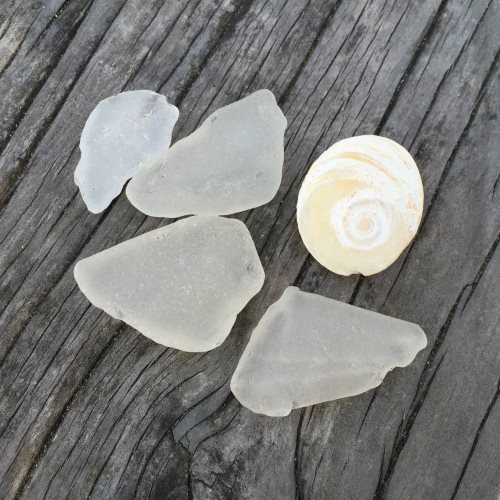
Sea Glass Found On Phillip Island
There are many more treasures for you to find as you go Phillip Island beachcombing! Discover!
Return to Top
Return to Phillip Island Beaches from Phillip Island Beachcombing
Return to Home Page
Keep in touch - sign up for my free newsletter!
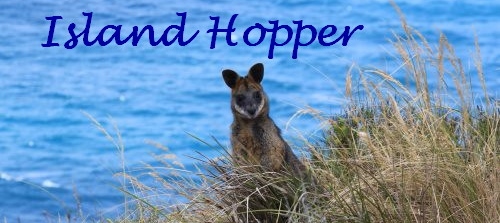
About Me Contact Me Site Map Privacy Policy
Copyright 2011-2024 phillip-island-balcony.com
All Rights Reserved
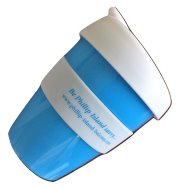
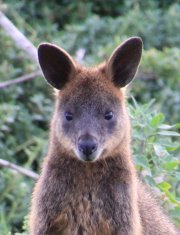
New! Comments
Have your say about what you just read! Leave me a comment in the box below.